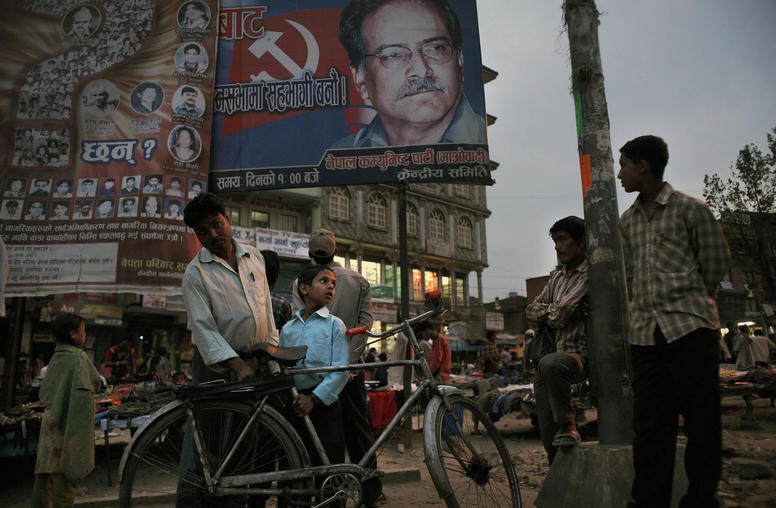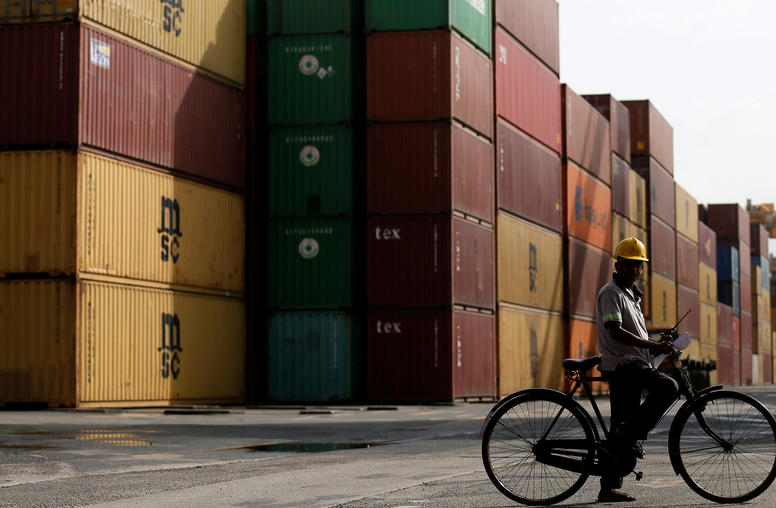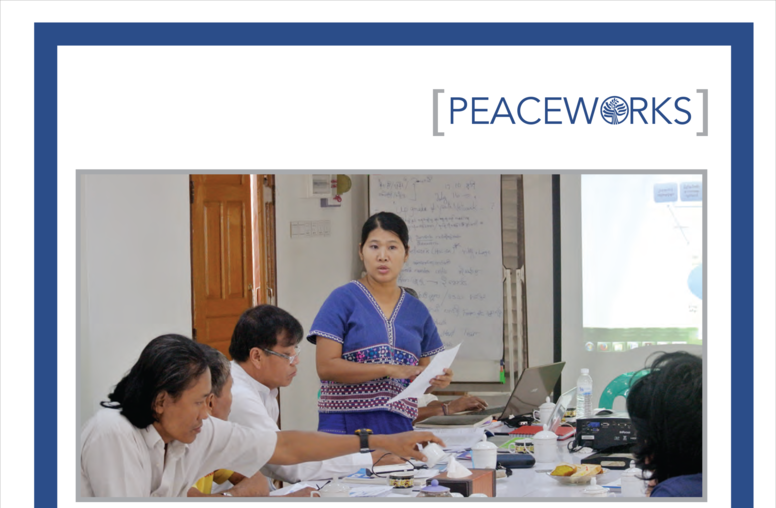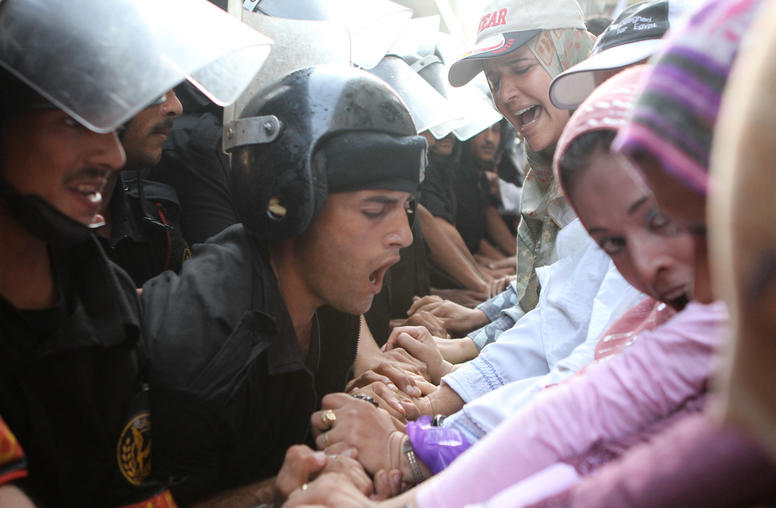Writer Nigel Quinney describes his first visit to Nepal, during which he observed USIP's Justice and Security Dialogue process - and the May 1 Maoist strike which shut down Kathmandu.
The North Korean restaurant in the heart of Nepal’s capital was playing possum when we arrived. With its lights turned off and shutters drawn, any passing UCPN-Maoist cadres would assume the restaurant was closed and leave it alone. And being left alone was certainly preferable to a visit from demonstrators. Hundreds of thousands of young men and women had been bussed in from the villages of Nepal to attend the next day’s May 1 demonstration and to enforce the indefinite general strike that the UCPN-Maoist leadership had called for May 2. Some of these cadres, bored or inspired by the relentless rousing speeches blasted from loudspeakers on trucks draped in red flags, had been visiting stores and cafes throughout Kathmandu, demanding “donations” from owners who knew that the price of refusal could be a brick lobbed through their front window. Local thugs had also taken advantage of the nervousness filling the capital, demanding their own “donations” from businesses in the name of Maoists.
Standing outside the restaurant, we telephoned to announce our arrival. Immediately, two young ladies wearing identical outfits and smiles emerged from a shadowy door further up the alley, walked toward us, raised the restaurant’s shutters, ushered us inside, and promptly lowered the shutters. Led into a private room, six of us sat around a large table while our Korean hosts brought us drinks. The karaoke machine played kitschy covers of songs by Lionel Richie and Peter, Paul, and Mary while showing slides of the glories of North Korean architecture. As our waitresses urged us to join them in their carefully choreographed renditions of “Say You, Say Me” and “Puff the Magic Dragon,” we sipped and waited for the police to arrive.
Since flying into Kathmandu four days earlier, I had been struck by a sense of rising apprehension so strong you could almost smell it—even above the exhaust fumes of Asia’s most polluted city. Maoist cadres were descending on the city, and no one was sure exactly how long they would be staying or exactly what they would be doing. There was also a tangible and entirely sensible fear of violence between the Young Communist League and the Youth Force, the youth wings of the Maoists and the UML (the governing party in Nepal), which clash frequently.
Bandhs—a mixture of street protests and general strikes—are hardly a rarity in Nepal, especially since late 2005, when the Maoists decided to exchange a bloody, stalemated, ten-year-old insurgency for the promise of establishing a republican polity with multiparty democracy and a new constitution to be drafted through the Constituent Assembly. The Maoists had joined with seven other political parties in a successful campaign to strip a reactionary monarchy of its political powers. Nepal had become a federal republic in 2008, and elections to its constituent assembly had seen the UCPN-Maoists emerge as the largest party. A coalition government had been formed by an alphabet soup of centrist and leftist groups: the NC (Nepali Congress Party), the UML (Communist Party of Nepal—United Marxist-Leninist), and the UCPN-M (Unified Communist Party of Nepal—Maoist). The Maoist leader Pushpa Kamal Dahal—better known by his nom de guerre Prachanda—had been elected prime minister. So far, so good for the fledgling peace process.
(Photo: UCPN-Maoist Leader Prachanda - second from right- riding through crowds of his supporters during the bandh. Photo by Shobhakar Budhathoki)
But in May 2009, Prachanda had resigned after his effort to remove the head of the politically powerful Nepali Army had been thwarted by the country’s president. Discussions between the parties on the drafting of a new constitution slowed to a crawl. Efforts to integrate Maoist fighters into the Army continued to be obstructed. Well-documented cases of human rights abuses committed during the civil war by both security forces and insurgents continued to go unpunished. Tensions mounted. Violence flared. Political gauntlets were thrown.
And thus, as I arrived in Kathmandu in the last days of April 2010, so did 200,000 Maoists. They were, their leaders declared, going to stay there until the prime minister (the aptly named Mr. Nepal, leader of the UML) resigned, a national government was formed, and consensus was reached on the extension of the Constituent Assembly as part of continuing the peace process.
The Maoists’ reluctant hosts, the politically jaded residents of the capital, were not so sure. At first, they confidently expected that the bandh would be called off before it began, that this was just another elaborate exercise in political posturing. But as the tightly disciplined Maoist encampments at the city’s major intersections grew larger and larger, so the shelves of the supermarkets and the baskets of the street vendors began to empty as people stocked up for an uncertain future. By the time we sat down in the North Korean dining room on the eve of the general strike, the most that my fellow diners dared hope was that the bandh would be short-lived—too short to let tempers smolder to the point where a spark of violence would inflame the entire city.
(Photo: Maoist cadres camped out at major intersections throughout Kathmandu throughout the general strike. The UCPN-M provided them with food, water, entertainment, and speeches)
My fellow diners were the reason I was in Kathmandu in the first place. Shobhakar Budhathoki and Karon Cochran Budhathoki are champions of conflict resolution and human rights, and together with their small team, they run USIP’s Strengthening Security and Rule of Law Project, which strives to foster understanding, dispel prejudices, and encourage cooperation among civil society, the police, local government, and political groups throughout Nepal. I had flown in to see their work close up, both in the capital and in the regions. The Maoists were doing their best to frustrate my plans with a strike that would empty the skies of domestic aircraft and the streets of anything other than pedestrians, rickshaws, and scrawny sacred cows. But thanks to Shobhakar and Karon, I had a head start on the Maoists and had already met several of the program’s leading supporters, including some of the country’s most distinguished human rights activists, two of whom were now studying the menu alongside me.
As we contemplated kalbitang and dongchimi, the police burst in. They were, understandably, late. Preparing to keep the peace in a city full of Maoists intent on ousting the prime minister is a demanding business, and the deputy inspector generals of Nepal Police (NP), the head of the training directorate, the head of counterterrorism, and the spokesperson for the Nepal Police had all had a busy day. They were determined, however, not to miss this dinner.
Like the human rights activists, these police officers are part of the project’s national focal group, which helps shape and evaluate project activities. As focal groups go, this one goes very well indeed. Not only are all the members deeply committed, highly enthusiastic, and remarkably well connected, but the group itself is a walking, talking example of the success of the Strengthening Security and the Rule of Law program. Twenty years ago, 10 years ago, even just five years ago, the members were on opposite sides of a fight between monarchy and democracy, tradition and modernity, order and disorder—between the defenders of security and the champions of justice. But today they are on the same side. They now see security and justice as two sides of the same coin: inseparable, mutually dependent components of that hard-to-define thing called “rule of law.”
(Photo: Nepal Police guarding the entrance to the Constituent Assembly Building. Photo by Shobhakar Budhathoki.)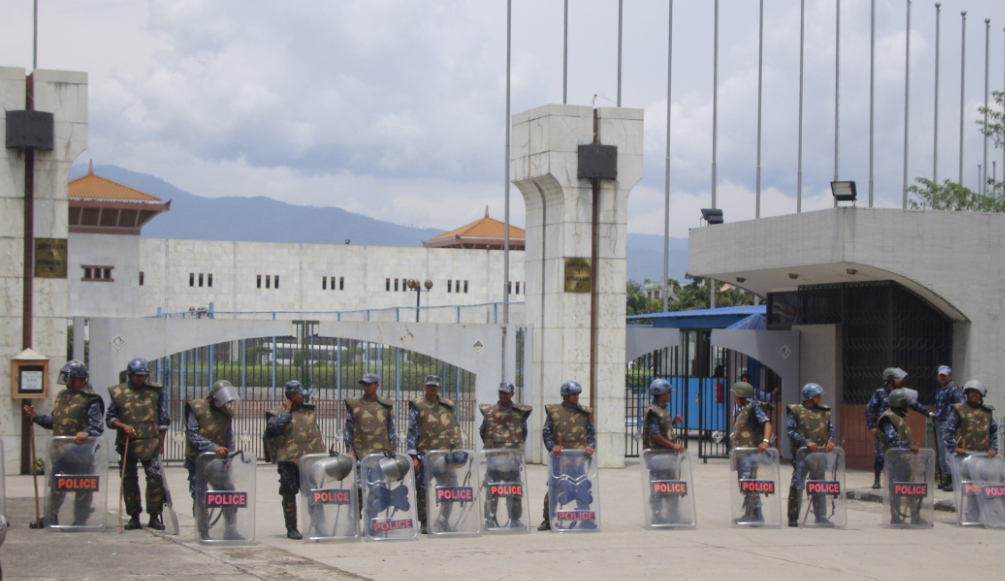
While the waitresses sang “If I Had a Hammer” and pictures of Pyongyang’s monstrous monuments flickered on the screen, my companions roared with laughter and swapped war stories of arresting and being arrested by one another. The laughter faded when the conversation turned to the events of tomorrow. Together, they somberly calculated the chances of the bandh passing off without protestors and security forces resorting to the kind of brutality seen during the civil war and people’s movements. Together, side by side at the same table, some of Nepal’s leading police officers and human rights activists assessed how the country might yet emerge unscathed from the impending clash.
These old foes had become firm friends. They were now joined in a common cause: preserving the peace, the peace process, and the limited but real political progress made in the past few years. They were also now united by a common concern: each other’s well-being. The evening ended with a series of toasts, glasses raised to everyone’s safety in the coming days. Outside, the UML was contemplating maintaining power whatever the cost, the Nepal Army was expecting to be called into action, and the Maoists were toying with revolution. Inside, a different kind of revolution was being celebrated.
* * *
It is tempting to end this little story there, in that peculiar restaurant, at that heartwarming moment, with our heroes about to enter the fray against a fearsome enemy. But this simple story is part of a much bigger tale, Nepal’s democratic future, and a happy ending to that tale depends on recognizing the country’s complexities and contradictions. Above all, it depends on recognizing that yesterday’s enemies can become tomorrow’s friends.
The Maoists are often seen—especially abroad—as the arch enemies of Nepal’s peace process, and marching in the street to force a change in government is hardly good parliamentary practice. But the Maoists are no fringe group; to the contrary, they won the most votes in the 2008 elections and can fairly claim the support of almost half of the country. Without the Maoists, Nepal would still be ruled by a repressive monarchy. Moreover, the aim of the bandh was not to topple the multiparty government; it was to reshape it. As such, the bandh can be seen, albeit paradoxically, as a Maoist vote of confidence in multiparty democracy and consensual decision-making.
To be sure, some within the Maoist ranks are implacably opposed to reconciliation, compromise, and all those other essential components of a sustainable peace. But they are not alone in this. As everyone I met in Kathmandu complained, the leaders of all political parties are guilty of playing party politics instead of focusing on good governance for the benefit of the country as a whole. Meanwhile, Hindu extremists have been doing their best to dent Nepal’s centuries-old reputation for astonishing religious tolerance. And the Army of Nepal, which used to be the power behind the throne and remains the single most potent actor in Nepal, refuses to implement the provisions of the peace agreement that call for integrating Maoist fighters into its ranks.
In the end, the bandh of early May 2010 lasted almost a week. With each passing day, it became a more fractious affair, the cadres growing more restless and the citizens of Kathmandu more resentful of the disruption to their lives. Large-scale violence was avoided, however, thanks primarily to the determination of the security forces and the Maoist leadership to keep a tight rein on their foot soldiers.
Some of the credit—not much perhaps, but some for sure—also belongs to the USIP project. In 21 districts throughout the country, USIP representatives and the focal group work with local nongovernmental organizations to design and implement programs that address local concerns and formulate locally workable solutions. In each district, the aim is to reach out to all concerned stakeholders: low as well as high-ranking police officers, Maoists and each of the other ingredients in the local political soup, representatives of the various ethnic and religious groups, women as well as men, lawyers as well as judges and prosecutors. The results of this process of education, facilitation, and inspiration are sometimes plain for all to see—such as the police and the youth working hand in hand to keep protests peaceful, curb drug abuse, investigate corruption, and even manage traffic. More often, the results are invisible but no less valuable—a growing realization among all stakeholders that there can be no justice without security, and no security without justice. The self-restraint shown by police and protesters in the streets of Kathmandu in early May suggests that both sides are learning something about mutual interests and mutual interdependence.
Nepal is hardly a bastion of the rule of law just yet. As anyone who has tried to drive on Kathmandu’s congested, chaotic streets can attest, Nepalis don’t have an instinctive compulsion to follow rules! The same holds true for major as well as minor issues. Four weeks after the bandh, for instance, the deadline for drafting a new constitution came and went, and the dissolution of the Constituent Assembly was averted only by a last-minute agreement between the three major parties—an agreement that does nothing to conceal their continuing disagreement over fundamental questions. Future crises are inevitable; so, too, are future bandhs. Nepal’s peace process will once again have to try to navigate safely through congested, chaotic political terrain. The outcome is as unpredictable as a Nepali bus schedule.
But one thing is certain: the chances of Nepal making it safely through another chapter in the epic of its peace process are improving thanks to the programs such as the USIP Strengthening Security and the Rule of Law Project. Thinking nationally and acting locally, the program is making a difference.
And it could make a difference elsewhere, too. Nepal’s circumstances are unique, but its needs—for peace, political cooperation, and rule of law—are not. The distinctive approach to justice and security dialogue that USIP has been pioneering in Nepal can be customized to fit many different countries emerging from conflict. At its heart are three key elements: a focus on partnership (between local, national and international actors); a focus on process (on facilitating a certain kind of dialogue rather than on achieving a certain kind of outcome); and a focus on pragmatism (on all sides working together to make real if initially modest improvements in the security and justice situation). These elements form a flexible framework that can be readily configured to work in almost any transitional state. Already, such an initiative is under way in Iraq. Several other countries—for example, Afghanistan—may also adapt the framework to suit their own circumstances.
In the end, the goal is to build peace, one dialogue at a time.
